The Andromeda Galaxy
The Andromeda Galaxy comes into view every autumn.
It is the furthest object you can see with just your naked eye.
And the light which enters your eyes left the galaxy 2.5 million years ago!
Andromeda Galaxy. Photo: ESA / Hubble
Andromeda is the largest spiral galaxy in our region of the universe.
It’s an object that holds a special place in our understanding of the cosmos.
And in four billion years time we’ll become part of it!
Quick facts
- The Andromeda Galaxy is the closest big galaxy to the Milky Way.
- Like our Milky Way Galaxy, Andromeda is a spiral galaxy.
- Its distance is about 2.5 million light years.
- Andromeda has a Messier Catalogue number of M31.
- It is larger than the Milky Way, about 150,000 light years across.
- Andromeda contains around 400 billion stars.
- It was first recorded in a Persian star catalogue in the 10th Century.
Place in cosmology
By the 18th Century, telescopes were good enough to make out hazy objects among the stars.
They were named nebulae, ‘clouds’.
Some of these ‘clouds’ seemed spiral in shape so were classified as ‘spiral nebulae’.
As early as 1755 German philosopher Immanuel Kant proposed that spiral nebulae were in fact ‘island universes’.
We now call them galaxies.
However other astronomers were convinced that the spiral nebulae were relatively close.
They were in our Milky Way. In fact the Milky Way was the whole universe.
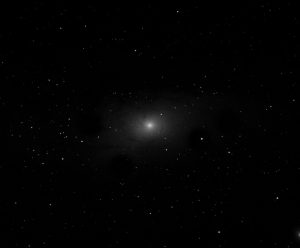
A ‘spiral nebula’. Photo: M. Johnson
These opposing ideas came to a head in the Great Debate of 1920.
Two eminent astronomers, Harlow Shapley and Heber Curtis,
each put their opposing views in a dramatic meeting in the USA.
The issue was settled in 1925, when Edwin Hubble studied M31.
He used the massive 100-inch Hooker Telescope on Mount Wilson, California.
Hubble showed that the Andromeda spiral was far beyond our Milky Way.
It was an individual star city, a galaxy.
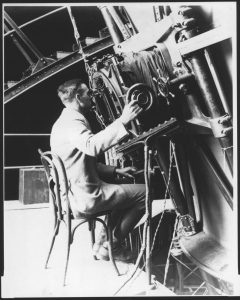
Edwin Hubble at the Hooker Telescope
Image: Edwin P. Hubble Papers, Huntington Library, San Marino, California
Our perception of the universe changed forever.
The universe is a vast, mostly empty space populated by billions of galaxies.
Measuring the Universe
Hubble was able to measure the distance of Andromeda because of the work of Henrietta Leavitt.
Henrietta was an astronomer at Harvard College Observatory from 1903 to 1921.
She discovered a way of measuring the distance of certain stars far beyond other methods of the time.
She studied stars called Cepheid variables.
These stars change brightness in a regular, metronomic way.
Henrietta showed that the time between peaks in brightness corresponded with the true brightness of these stars.
The longer the period, the brighter the star.
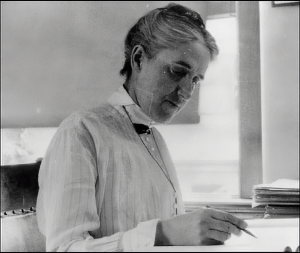
Henrietta Leavitt. Photo: AAVSO
This Period- Luminosity Law proved to be the key to measuring the distance of those ‘spiral nebulae’.
For Edwin Hubble, his task was to find a Cepheid variable in the Andromeda spiral.
If he could measure the time between brightness peaks, he would know its true brightness.
The difference between this true brightness and its apparent brightness would be a measure of its distance.
Hubble and Andromeda
Finding a Cepheid in Andromeda was no easy task.
We now know that it lies a huge distance from us,
The stars in M31 were minute points of light.
But with the big Hooker Telescope, Hubble did it.
At first Hubble thought his star was a nova, a star undergoing an outburst of energy.
But further observation saw the star dim, then brighten a again.
He had found the key to measuring the distance of M31.
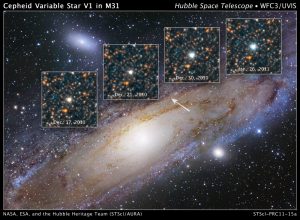
Cepheid V1 in M31. Photo: ESA / Hubble
Hubble first estimated the distance at one million light years.
This placed it far beyond the realm of the Milky Way.
Since 1925, the distance has been recalculated and stands at 2.5 million light years.
So when you glimpse M31, you are seeing it as it was two and a half million years ago!
How to find M31
As ever, Stellarium will help you to find M31 in the autumn sky.
Stellarium is our chosen software for Wonderdome and you can download it for free here!
This year Jupiter is a good place to start.
Jupiter shines in the southern sky, brighter than any star.
Look above Jupiter and you’ll see four stars forming a big square.
This is the Square of Pegasus.
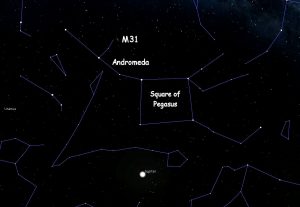
M31 finder chart 1. Image: Stellarium
Go to the top left star. Then count three stars to the left.
These are stars in the constellation of Andromeda.
Then count three stars up.
Just beyond this star is the hazy glow of the Andromeda galaxy.
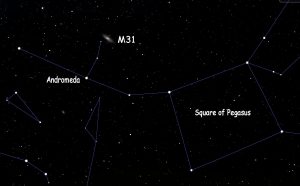
M31 finder chart 2. Image: Stellarium
Binoculars will show the glow more clearly and a small telescope is even better.
Even so, you will only see the heart of M31, its centre, its nucleus.
If you could see the whole galaxy with its spiral arms, it would appear much bigger than our Moon!
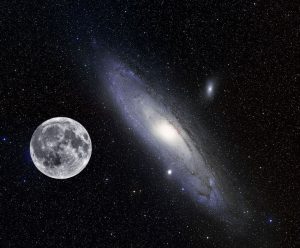
Size of Moon and M31 in our sky. Dennis Ashton
Cosmic Collision!
After Hubble had measured the distance to Andromeda and a few other galaxies, he made another astounding discovery.
He used a spectroscope to analyse the light from these distant star cities.
The spectroscope showed that the wavelength of light in these galaxies had been stretched.
This stretching is termed redshift.
It is caused by the galaxies moving away from us – and each other.
By 1927, we knew that the universe is expanding, getting bigger all the time.
This resulted in the theory of the Big Bang, the creation of the universe some 13.8 billion years ago.
In fact, the galaxies are not really moving.
It is space which is getting bigger and taking the galaxies with it.
But Andromeda was different.
Its light was blue shifted. It is coming towards us!
The mutual gravity of Andromeda and the Milky Way is drawing the two galaxies ever closer.
The closing speed is around 250,000 miles per hour.
In the last hour, M31 has moved a quarter of a million miles nearer to us!
Since this time yesterday, it is six million miles closer!
The two mighty star cities are on collision course.
But the distance between them is so great that even at the enormous approach speed, the collision will not happen for another four billion years.
Phew!
The following dramatic sequence of NASA images shows what this cosmic collision will look like from Earth.
For more details click on the NASA page here.
Image credits: NASA; ESA; Z. Levay and R. van der Marel, STScI; T. Hallas; and A. Mellinger
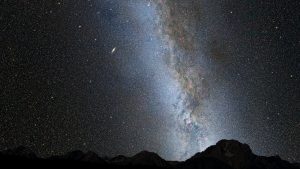
Milky Way and Andromeda now.
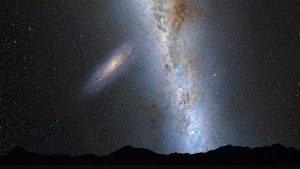
Two billion years from now.
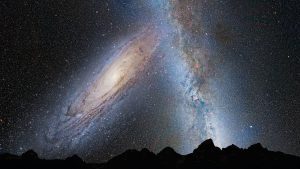
3.75 billion years from now.
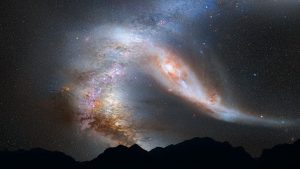
4 billion years from now: galaxy collision.
The two galaxies will eventually merge together to form a huge new star city.
An important object
The Andromeda Galaxy has played a significant role in our understanding of the universe.
Measuring its distance showed that the universe is unimaginably big.
And it has an important place in the future of our home planet.
We are destined to literally become part of it.
The author: Dennis Ashton is a Fellow of the Royal Astronomical Society and a Wonderdome presenter.
Would you like to hear more Astronomy news?
Do you want to to find out about our upcoming public events?
Follow WonderDome Portable Planetarium on Twitter and Facebook or go to our web site wonderdome.co.uk!

